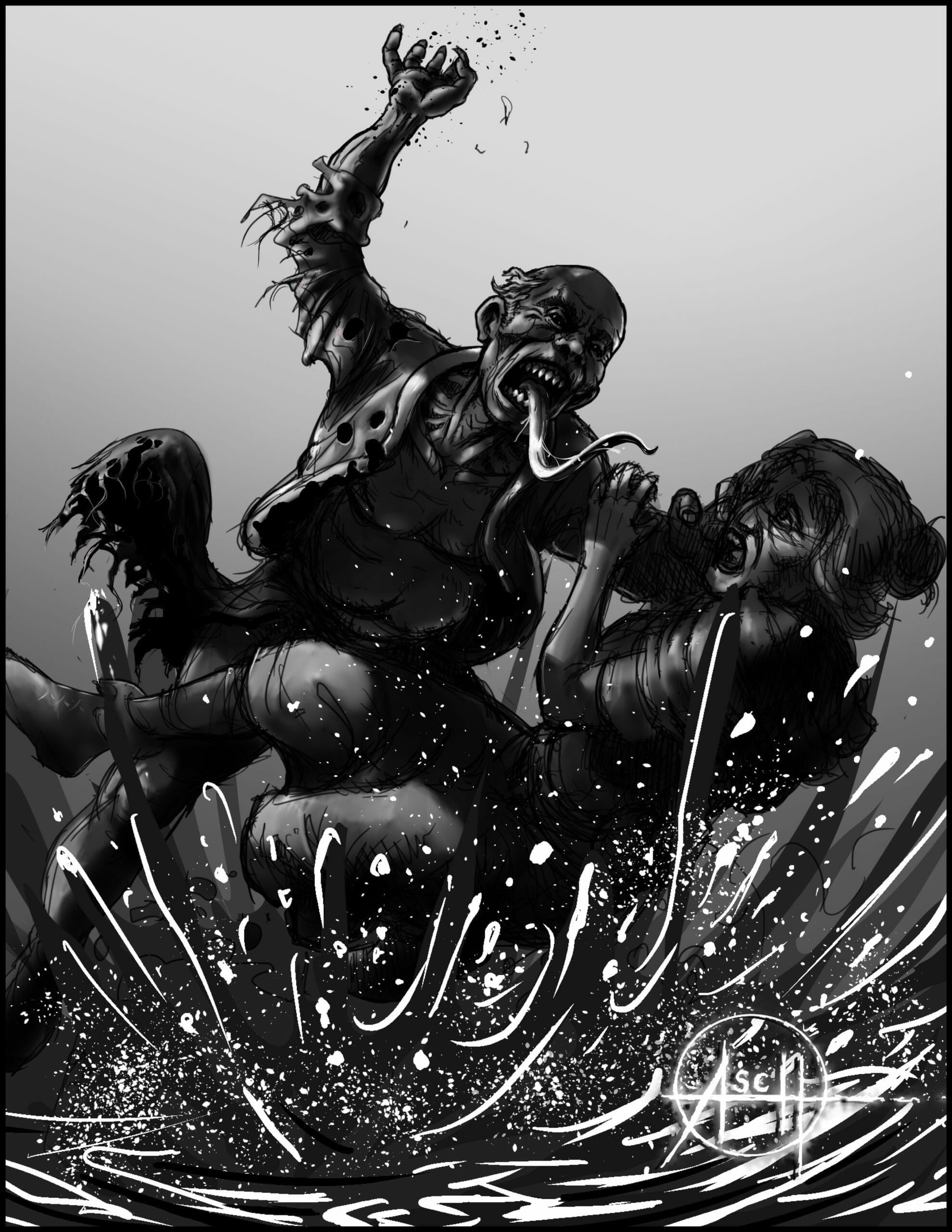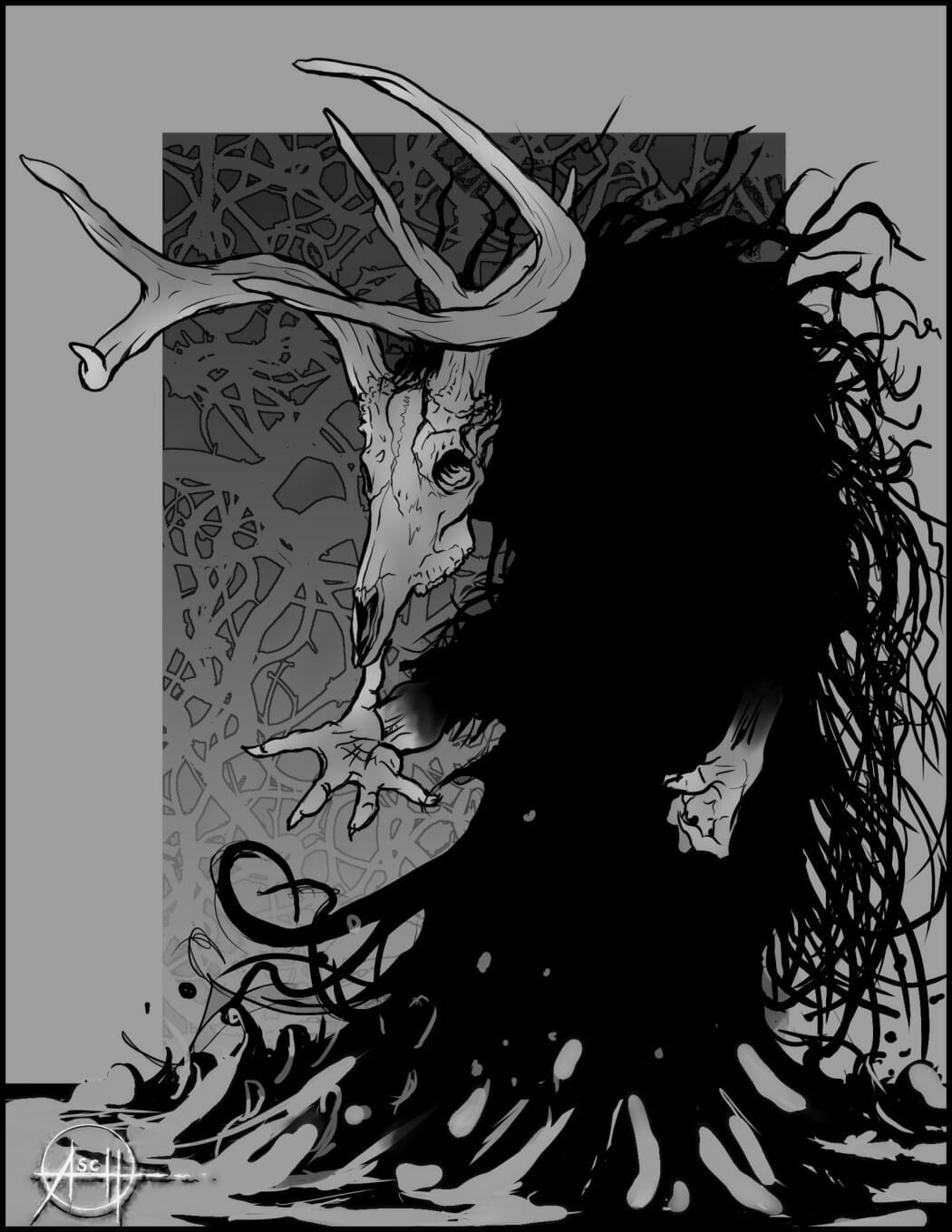Knight of the Sun is a 5e adventure module for 3 to 6 characters of levels 2 to 4. It’s on Kickstarter, has two weeks left to fund, which it is about to do.
Yes, I know. Kickstarter is full of 5e RPG modules. Why talk about Knight of the Sun? Geek Native has some exclusive art to share, a Q&A with the artist Aschiael of 451 Studios and Mad Hermit, the story designer.
Knight of the Sun is an adventure that fully embraces that your party of so-called heroes could go the evil route. That doesn’t just add to the replayability or even helpful given how rare evil D&D adventures are, but it also tickles at the moral dilemma PCs often encounter. You can read more about the adventure itself on Kickstarter.

What’s the elevator pitch for Knight of Sun. You’re a busy DM, too busy even to be persuaded; what three-sentence comment is going to talk you into running the game?
The story of the module takes some inspiration from the story “the Thing”. It takes place in an isolated village with a dungeon/tomb nearby that the PCs have to find their way into to save the village or accomplish their goals.
Depending on the approach taken to the story the PCs are either trying to save the village and end up uncovering a a greater evil plot of worldly proportions, or they are working against rival Cultists to steal/undermine their glory in the eyes of their evil God.
There is a level of control here that the DM should be happy with; The ability to elevate the sense of danger can range from murder mystery-esque, to horror movie survival struggle or even cthonic apocalypse.
Aren’t evil parties in D&D notoriously hard to run? Do you recommend them?

They can be. It kinda depends on the approach being taken. If the PCs are undertaking this story from the evil side of things, then they are all Cultists of Orcus trying to figure out what some rival Cultists of Orcus are doing in the village.
They aren’t advertising their roles as Cultists while they are doing this. They are trying to stay hidden (as they always do), posing as normal people who are (ostensibly) trying to help out the village. But their true goals are very much directed toward thwarting their rivals and stealing away the prize those evil rivals are seeking for their own faction’s evil gain.
If they can accomplish it, they will stand to gain full membership into their home Cult and gain a great deal of power thereby. Their true purposes are purely evil (for the greater glory of Orcus), but their “apparent” goals simply seem to be to help. So that adds some nuance to the evil take here.
They aren’t just out to murder and defile their way to their goal, and won’t be able to reach their goals if that’s their approach. They have to be more sly than that, and more subtle.
Where their evil comes out in this story is in the purposes behind the actions the PCs are taking, and how well they maintain the guise of (at least) “normality,” if not “goodness” in the course of all that.

However, there are going to be plenty of ways in which evil characters approach and deal with different problems in the course of the story where their colors are likely to shine through. And it’s in all those sneaky regions around the edges of things that the more entertaining side of the evil campaign will shine.
As to whether or not that we might recommend an Evil campaign or play through, I guess it comes down to how well a DM’s players can pull it off; posing as goodly types while seeking goals that serve only their own evil ends.
It’s not the blatantly evil acts that would prove entertaining here. It’s how well the PCs can manage to blur the lines they are walking.
Is there something cathartic about releasing your inner dark through the safe medium of a game? Why do you think that is?
There probably is something cathartic in murder-hoboing your way through a story, but that’s not exactly what Knight of the Sun is calling for.
The murder-hobo style evil is really just the blunt fist of a bully’s approach to things. That’s a very simple view of it, in general. What the evil PCs involved in this story are doing requires a bit more mental agility than that. They have specific goals to further their own ends and they don’t want what they are actually doing broadcast. Evil done with clear purpose from behind a set of veils is always a more subtle tightrope walk.
In this story, the evil PCs play as members of a secret Cult of the God of Undeath. There may be some catharsis in accomplishing their end goals (and stealing the prize away from their rivals), but that energy is secondary to all the added stresses these characters will face in trying to maintain the facade of being something else entirely… It’s not so very cut and dried.
The catharsis comes from a sense of selfish accomplishment and the ability to out-plan and manipulate the situation to achieve the desired result, as well as clever improvisation when all else fails (and it will.)
How do you define OSR? How does Knight of the Sun achieve that?

In the main, as a movement, the OSR trend is a kind of rejection of continuing to alter games just for the sake of altering them (as if they were PC programs to be updated constantly).
But by way of feeling, OSR style games seem to move RPGs back a step or two and realign them more with the idea of character death as a real factor.
The constant effort to make things perfectly balanced and fair is not really the point of these games. Playing wisely is.
RPGs really sing when character death is a very REAL possibility. It tends to make the players sharper, and their approach to situations in the game more careful.
That and some of the older RPG systems run everything just fine from simpler systems. That’s probably the biggest part of it for most people. It gives the games a certain type of feel that is really exciting.
In Knight of the Sun, we definitely err toward the more difficult side of the story coin. PCs in this story are simply out-matched and outnumbered, and to overcome what they end up facing, they’ll have to move very carefully and thoughtfully.
Even so, I think most DMs will find they need to pare back the difficulty level in the dungeons a bit. The idea is have the PCs end up being chased through the dungeons, but if a party isn’t willing to flee from time to time, they are probably going to die in these dungeons. Which is half the fun of an OSR style game anyway!
Does the module nudge players towards a particular style of play? Do you nurture that dark side through the moral dilemmas included?

So there are a few sticky social style encounters in the module that players will certainly come at differently depending on whether they are a good or an evil party.
However, the nuances of these differences will be one of the more interesting things for the DM in the course of the story depending on the approach that the player’s take. But those dilemmas would be tricky from either angle (good or evil), so there is really no prescribed method to face them.
Some of the social interactions in the village are especially this way, and they get a bit more stressful as the game goes along; the situation heightens the stresses coming out of the story.
I think DMs are going to get a kick out of how their players deal with a panicking, isolated and cut off village suffering waves of Undead incursions while at the same time trying to sort out how to track down the Necromancer behind all the trouble in the story.
We’ve tried to lay the groundwork for everything that can go wrong to do so, so that the DM can be entertained as the PCs struggle to work through it all.
A little birdy told me there’s some Easter Eggs hidden in the game. Is that true? Can you give us some clues?
We have gone to some lengths to hide in a good deal of foreshadowing of the future modules in this series. We are also making sure to tweak things between the various formats of the module.
For instance, the printed books will contain items and NPCs that are different in the .pdf versions, and all of that will be altered again in any future releases of the material.
We want to lend a collectors value to the print copies of the module and so will be swapping out and altering out portions of the artworks. Some of the loot and some of the correlations between characters will seem almost negligible initially, and discovering their purpose and intentions may be nigh on impossible. However, there are those sleuths out there…

Quick Links
Geek Native has a comment section. You can find it just below here.

